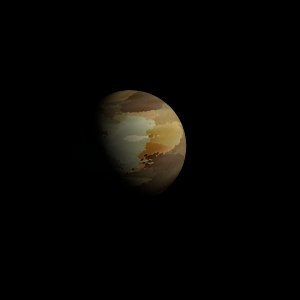|
|
Space Astro
|
Info for exoplanet "Heneri-ko"
| Scientific (actual) data |
|---|
| Name | Kepler-234 c |
| Planet status | Confirmed |
| Radius | 0.313 |
| Orbital period | 7.21205 |
| Semi major axis | 0.077 |
| Discovered | 2014 |
| Updated | 2021-02-05 |
| Tconj | 2455010 |
| Impact parameter | 0.16 |
| Publication | Announced on a website |
| Detection type | Primary Transit |
| Alternate names | 2MASS J19263684+3829407 c, K00800.02, KIC 3342970 c, KOI-800 c, KOI-800.02, WISE J192636.84+382940.7 c |
| Star name | Kepler-234 |
| Right ascension | 291.65° |
| Declination | 38.49° |
| Mag j | 14.387 |
| Mag h | 14.104 |
| Mag k | 14.065 |
| Star distance | 1821.01 |
| Star metallicity | 0.075 |
| Star radius | 1.11 |
| Star temperature | 6224 |
| Star alternate names | 2MASS J19263684+3829407, KIC 3342970, KOI-800, WISE J192636.84+382940.7 |
| Wikipedia article | Kepler-234 c |
Back
| |
| Fictional info (?) |
|---|
| Suggested name | Heneri-ko |
| Planet type | Hot planet |
| As seen relative to the fixed stars, it rotates on its axis exactly five times for every five revolutions it makes around Kepler-234.
It is radically different from Earth in other respects.
The volume of water ice in the south polar ice cap, if melted, would be sufficient to cover the entire planetary surface to a depth of 9 meters.
The largest moon, Yzeb-ojet-ira, has a diameter greater than that of the planet Jupiter. |
| Atmosphere | Xenon | 36% |
| Neon | 35% |
| Ammonia | 22% |
| Hydrogen | 3.2% |
| Argon | 2.8% |
| Ammonium hydrosulfide (NH4SH) | 0.03% |
| Hydrogen deuteride (HD) | 0.0014% |
| Atmospheric pressure | 0.001 bar |
 |
| Moon | Uqep Yqob'ece | Very small irregular crater-filled moon |
| Yzeb-ojet-ira | Small almost round crater-filled asteroid |
| Gekubo | Huge potato shaped crater-filled moon |
| Zeror Ysepym | Huge round rocky moon |
| Google search for Heneri-ko |
|
Website by Joachim Michaelis
|
|
|
|